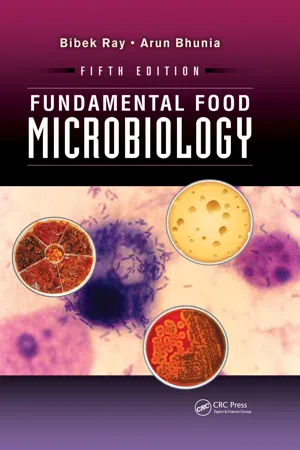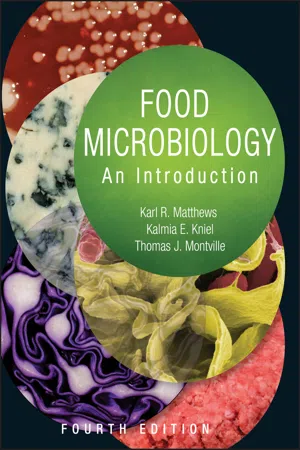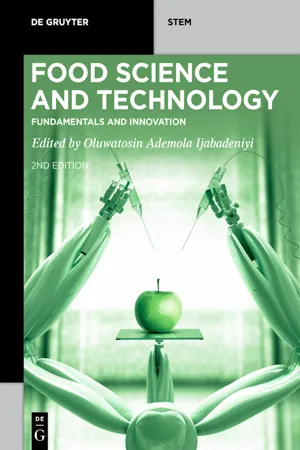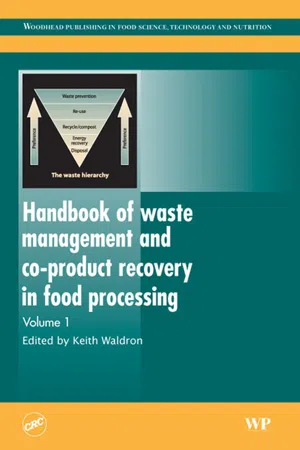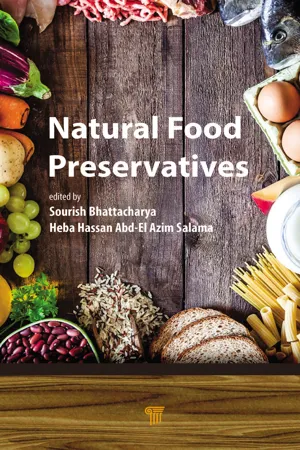Biological Sciences
Food Production Microbiology
Food production microbiology is the study of microorganisms involved in food production processes, including their impact on food safety, quality, and spoilage. It encompasses the understanding of microbial growth, metabolism, and control in food production environments. This field plays a crucial role in ensuring the safety and quality of food products for human consumption.
Written by Perlego with AI-assistance
Related key terms
6 Key excerpts on "Food Production Microbiology"
- eBook - ePub
- Bibek Ray, Arun Bhunia(Authors)
- 2013(Publication Date)
- CRC Press(Publisher)
From the above discussion, it is apparent what, as a discipline, food microbiology has to offer. Before the 1970s, food microbiology was regarded as an applied science mainly involved in the microbio-logical quality control of food. Since then, the technology used in food production and processing, distribution and retailing, and food consumption patterns have changed dramatically. These changes have introduced new problems that can no longer be solved by merely using applied knowledge. Thus, modern-day food microbiology needs to include a great deal of basic science to understand and effectively solve the microbiological problems associated with food. The discipline includes not only the microbiological aspects of food spoilage and foodborne diseases and their effective control and bioprocessing of foods, but also basic information of microbial ecology, physiology, metabolism, and genetics. This information is helping to develop methods for rapid and effective detection of spoilage and pathogenic bacteria, to develop desirable microbial strains by recombinant DNA technology, to produce fermented foods of better quality, to develop thermostable enzymes in enzyme processing of food and food additives, to develop methods to remove bacteria from food and equipment surfaces, and to combine several control methods for effective control of spoilage and pathogenic microorganisms in food.An individual who has completed courses in food microbiology (both lecture and laboratory) should gain knowledge in the following areas:-
Determining the microbiological quality of foods and food ingredients by using appropriate techniques
-
Determining the microbial types involved in spoilage and health hazards and identify the sources
-
Understanding factors contributing to the emergence of new pathogens or the reemergence of old pathogens
-
Understanding the basic mechanism of pathogenesis of foodborne microbes
-
Designing corrective procedures to control the spoilage and pathogenic microorganisms in food
-
Learning rapid methods of isolating and identifying pathogens and spoilage bacteria from food and the environment
-
Identifying how new and novel technologies adapted for food processing can have specific microbiological problems and designing methods to overcome the problem
-
Designing effective sanitation procedures to control spoilage and pathogen problems in food-processing facilities
-
Effectively using desirable microorganisms to produce fermented foods
- eBook - ePub
Food Microbiology
An Introduction
- Karl R. Matthews, Kalmia E. Kniel, Thomas J. Montville(Authors)
- 2019(Publication Date)
- ASM Press(Publisher)
I BASICS OF FOOD MICROBIOLOGY1 The Trajectory of Food Microbiology2 Microbial Growth, Survival, and Death in Foods3 Spores and Their Significance4 Detection and Enumeration of Microbes in Food5 Rapid and Automated Microbial Methods6 Indicator Microorganisms and Microbiological CriteriaPassage contains an image
1 The Trajectory of Food Microbiology Learning Objectives The information in this chapter will help the student:- increase awareness of the antiquity of microbial life and the newness of food microbiology as a scientific field
- appreciate how fundamental discoveries in microbiology still influence the practice of food microbiology
- understand the origins of food microbiology and thus anticipate its forward path
Introduction Who’s on First? Food Microbiology, Past and Present To the Future and Beyond Summary Suggested reading Questions for critical thoughtINTRODUCTION
A former president of the American Society for Microbiology (Box 1.1 ) defined microbiology as an artificial subdiscipline of biology based on size. This suggests that basic biological principles hold true, and are often discovered, in the field of microbiology. Food microbiology - eBook - ePub
Food Plant Sanitation
Design, Maintenance, and Good Manufacturing Practices
- Michael M. Cramer(Author)
- 2022(Publication Date)
- CRC Press(Publisher)
Chapter 3 Microorganisms of Food Manufacturing Concern DOI: 10.1201/9780429294341-3 If it don’t stink, stuff it! —Anonymous food plant employee They go by many names: germs, bacteria, microorganisms, microbes, even “bugs.” They have been the main focus of several Hollywood movies, including The Andromeda Strain and Outbreak. In The War of the Worlds by H. G. Wells, they were responsible for saving the human race because Martian invaders had no resistance to bacteria that man had been accustomed to for millennia. Microorganisms have been on Earth for millions of years, longer than man. Microorganisms Microorganisms are biological entities, and they can be a benefit or a potential hazard to humans and to the food manufacturing industry. Bacteria represent the largest group of microorganisms [ 1 ]. Most bacteria are harmless; in fact, some provide benefits to humans by protecting the skin and nasal passages and also aid in the digestion process. Some also benefit the food industry when they are used for the production of cultured items such as cheese, yogurt, and fermented sausage. However, they can pose a threat to humans and to the industry when they result in foodborne illness and food spoilage. Microbiological contamination of food may result in product spoilage, reduction in shelf life, or foodborne illness. It is important to understand food-related microorganisms, with regard to growth needs and environmental requirements to better understand their control mechanisms. Fortunately, the food industry has evolved from the dinosaurs who truly believed that if something does not stink, it is OK to stuff to a more science-based understanding of microorganisms that impact the food industry. The common microorganisms that will be reviewed in this chapter, as they relate to foods, are indicator organisms, spoilage organisms, and pathogens - eBook - ePub
Food Science and Technology
Fundamentals and Innovation
- Oluwatosin Ademola Ijabadeniyi, Oluwatosin Ademola Ijabadeniyi(Authors)
- 2023(Publication Date)
- De Gruyter(Publisher)
The existence of a microorganism is an indicator of contamination at any stage of production (Caldera 2014), especially if the presence of such microorganism(s) is not desired. The predominant spoilage of microflora in a food is determined by microbial types, food types, and food environment. Due to chemical, biological, or physical agents, food spoilage may occur (Principles of Food Spoilage). The most important fac tors influencing microbial growth in food can be either intrinsic [nutrient content, water activity (a w), pH value, redox capacity, the availability of antimicrobial substances and mechanical barriers to microbial invasion, and environment-related factors in which the foothold occurs] or extrinsic (interactions between food contaminating microorganisms, food composition, packaging and storage conditions of food products, e.g., their ability to use various nutritional sources, withstand stress, and produce growth promoters or inhibitors of other microorganisms; processing factors include treatments such as heating, cooling, and drying, which affect the composition of the food and also the types and numbers of microorganisms that remain in the food after treatment) (Hamad 2012). 7.2 Flour and bakery products In most of the countries and cultures, bakery products are the main staple foods. Bakery products provide most of the food calories and about half of our protein requirements as a valuable source of nutrients for our diet. In general, the use of whole and organic grains and other natural ingredients has increased the popularity of bakery products (Saranraj and Geetha 2012). The cleaning and grinding processes have little or no direct impact on the level of contamination in wheat; thus, the initial grain quality has a strong influence on the overall safety and quality of the finished products - Keith W. Waldron(Author)
- 2007(Publication Date)
- Woodhead Publishing(Publisher)
In order to use the range of food-grade preservation methods available optimally, it is important to understand their characteristics, and any interactions that occur between them. Preservation is intended to prevent or retard deterioration that may otherwise be inevitable in co-product streams or end-products due to the effects of changes in their biochemical, chemical, physical or microbiological state. However, what follows deals with measures to control micro-organisms. The methods of preservation described aim to either kill the micro-organisms, or prevent or retard their multiplication. By so doing, the methods of preservation should aim to prevent microbiological spoilage, but should also prevent the growth (and preferably survival) of, and production of toxins by, food-poisoning micro-organisms.Typically, substrates that support microbial growth have a naturally occurring microflora, the growth of which may be desirable (for example in cheese or yoghurt). If the growth of these associated micro-organisms is not controlled then microbiological deterioration, causing subtle changes in the characteristics of the product, may occur (e.g. increased acidity in dairy products). Microbiological spoilage is often much more in evidence, however, when contaminating micro-organisms grow in, or on the surface of, products, and produce characteristics that are typical of the particular substrate and micro-organism concerned. This combination is then clearly recognisable as spoilage. Examples are the growth of moulds or surface films of yeasts and bacteria, and the production of gas due to the growth of fermentative yeasts.The presence and multiplication of potentially pathogenic bacteria are frequently less obvious. For example, food-poisoning bacteria may multiply to infective concentrations without causing any noticeable change in the organoleptic properties of products. In some cases the multiplication of pathogenic micro-organisms is paralleled by the growth of spoilage micro-organisms, which results in spoilage and deters consumption of the product, although this is by no means always so. Inadequate food preservation, therefore, may result either in significant public health hazard, due to the growth of potentially pathogenic micro-organisms, or in wastage of products due to the growth of spoilage micro-organisms.- eBook - ePub
- Sourish Bhattacharya, Heba Hassan Abd-El Azim Salama(Authors)
- 2023(Publication Date)
- Jenny Stanford Publishing(Publisher)
Chapter 1 Introduction to the Microbiological Spoilage of Foods and Beverages Ashraf Mahdy Sharoba Food Technology Department, Moshtohor Faculty of Agriculture, Banha University, Egypt [email protected]Food spoilage is a complex ecological phenomenon, caused mainly by the biochemical activity of specific groups of microorganisms. Microbiological spoilage of foods and beverages is the main cause of quality deterioration in these commodities. Microorganisms (i.e., bacteria, molds, and yeasts) associated with spoilage as well as factors affecting their growth and determining their eventual dominance in foods and beverages are presented. During harvesting, processing, and handling operations, food may become contaminated with a wide range of microorganisms. Subsequently, during distribution and storage, only a small fraction of these will develop and cause serious deterioration. Which microorganisms will develop is dependent upon food derived or environmental factors. The loss of food quality for the most important food commodities depends on the microbiological load. Food spoilage may be caused by a wide range of reactions including some that are mainly physical or chemical and others due to the action of enzymes or microorganisms. The primary factors associated with food spoilage are associated with intrinsic food properties and (cross) contamination during harvesting, slaughter, and processing in combination with temperature abuse. For fresh foods, the primary quality changes may be bacterial growth and metabolism resulting in possible pH changes and formation of toxic compounds, off-odors, gas, and slime formation. Despite the fact that food spoilage is a huge economical problem, it is obvious that the mechanisms and interactions leading to food spoilage are very poorly understood. In this chapter, we will deal with the most important causes of microbial corruption in food and beverages and the most important and most famous types of microbial corruption in food and beverages and the extent of the risk of these types of microorganisms to the quality of food products and the health of consumers in addition to discussing how to reduce or prevent the occurrence of microbial corruption in food and beverages.
Learn about this page
Index pages curate the most relevant extracts from our library of academic textbooks. They’ve been created using an in-house natural language model (NLM), each adding context and meaning to key research topics.
